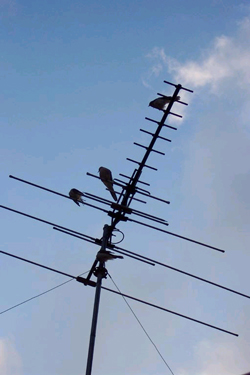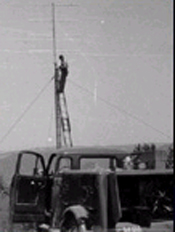|
Cable Television
Cable television first existed as internal distribution centers for the intent of distributing televisions signals in multi-use applications. This early configuration were referred to as Community-Access Television, or CATV.
Early CATV systems used multi-output cables to carry the signal from a master antenna on the roof down to multiple wall outputs, the system designed to service large apartment complexes. Distribution signal amplifiers were used to keep the signal strength constant into each apartment, as each split cable line going into individual apartments created a signal line loss, and why amplifiers were always needed. I mention this because this system is not much different from the one used today is larger homes that have multiple cable outlets going into individual rooms in the house, distribution amplifiers installed by the cable company to maintain useable signal strength for all rooms installed with a 75-ohm wall output jack. If the individual signal strength of any room's cable output would dropped below the 40-decibels threshold (a benchmark measurement for minimal acceptable signal strength), one would start to see video noise in the picture . . . or what was commonly known as "snow" in the good old days of poor signal strength. Since this is so rare today, younger people may not even know what the term electronic snow meant, though they probably are familiar with the unrelated audio terms of "white noise" and "pink noise.*" Cable television evolved from apartment building CATV systems into large community transmission systems that could provide local broadcast channels to people who lived in large and small rural communities and could not successfully receive them on their own. Either being too far from the original television station's transmission tower or having that signal blocked because to high surrounding terrain or mountains, people needed a central source to provide them with programs from broadcast television stations that were located at least an hour's drive away.
To meet this demand, cable companies built large towers and located them up on high terrain that could easily receive the on-air signals from nearby cities. These signals were then sent down on a cable to the cable company's Head End. These signals were then boosted through the feeder cable lines that were strung across the community hanging from existing networks of telephone poles. As communities enlarged, so did the cable companies themselves, creating larger corporate buildings that held in-house production studios, which added the benefit of local programming assigned to non-used cable channels. The cable company later added additional content that came from what was called premium channel providers, whose signals were picked up by satellite dishes located at the cable-company's corporate Head End. These new premium channels came from new content providers with names such as Home Box Office (HBO), one of the first providers of an all-day movie channel. These unique providers transmitted their programming to the cable operators, (called a user), via the new satellite technology. These premium channel providers made their profits by selling first-run movies to cable franchises across the country, which in turn would pay for them through subscriber fees from their customers who had upgraded from the cable basic service to what the cable company called its premium movie service. This service was made available to the cable company's subscribers though their use of in-home decoder boxes connected to the cable system network that was leased for a small monthly fee of a few bucks. The cable company could then electronically scramble the premium movie signals so they could not be viewed on the television sets of subscribers who had not subscribed the more expensive premium service, allowed only to view the basic package of channels. Cable companies that could not afford the more expensive cable descramble boxes that allowed easy and almost instant upgrading for subscribers to see these premium channels, achieved similar results through the use of coils located high up on telephone poles outside the subscribers home. These coils would be detuned to prevent non-subscribers from seeing the premium channel on their television sets. Once the customer had subscribed to the premium service, a cable technician was scheduled to climb the telephone pole outside the customer's home to physically tuned-in the external coils. This allowed the premium channel signal to then pass through for upgraded viewing. Content providers like HBO were also able to operate from one location in the country by beaming their content up to unique satellites that sent them back down to subscriber cable systems located across the country. These satellites were arranged in space so their signals could be picked up anywhere in the United States through their "footprints," the satellite company's description of the areas on the earth that could receive their satellite's signal.. This new content allowed potential cable subscribers to see the benefit of cable programming over broadcast-only programming. So it was natural that people started throwing away their outside antennas and stepping up to cable-only programming, which began because of the needs of smaller communities in the United States. These cable companies could provide much more content for viewers then the original two or three broadcast channels they had previously received though the use individual outside antenna's mounted on the roof of their homes. A new communication industry had been born. Soon multi-channel cable programming was demanded by viewers in markets that already could easily receive close to a dozen broadcast channels such as in New York, Chicago, and Los Angeles. These broadcast-only customers wanted the new content of movies and other unique programming that only a cable system could offer. And that's how the cable systems we see today were born, now so popular one rarely see anyone putting up an antenna on the roof of their home. The result of this was the sale of annoying external antennas dropping to almost zero in many locations around the country. Many of today's cable providers have digital cable boxes that allow subscribers, who are enrolled in their full-movie package, to start any movie running in their home at any time and at no extra cost. This is called Digital-on-Demand programming. Now, instead of checking the cable guide to see when a movie was going to run, the subscriber would simply go to the Digital-on-Demand channel and select the movie provider (HBO, Cinemax, Starz, Encore, Showtime), then a movie by category that is running that month. Pull out the popcorn and push "play" on the cable remote control to start the movie. Need to answer the door? Press "pause" or
go back later or the next day. The system will remember where you
stopped watching as long as that movie is still scheduled to play
on cable.
Go to Chapter 3, "Programming"
Copyright freedomisknowledge.com 2007-2008 |
|
Index
|

